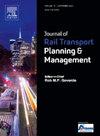A two-stage, single-tier, restricted blocking plan and train design approach based on candidate blocks
Abstract
Blocking plan and train design (BP&TD) is critical in freight rail planning, which integrates blocking and train routing to determine which pairs of yards are to provide blocks and train services, and the sequence of blocks and train services for each shipment. In this paper, a system-level and restricted BP&TD problem is addressed in a two-stage method. In the first stage, a system-level BP design problem that takes line capacity into account is investigated. A candidate block set-oriented approach is proposed to reduce the solution space of the problem by generating a set of promising candidate blocks based on the K-shortest paths algorithm. Two integer linear programming (ILP) models are developed to address this problem in a sequential way and an integrated way, respectively. Based on the optimized blocks and a systematic analysis of the cost of double-block trains, a post-optimization method is proposed in the second stage to solve a system-level TD problem by consolidating some single-block trains into double-block trains. Numerical experiments conducted on two benchmark networks indicate that our approach is capable of obtaining high quality solutions for the system-level BP&TD problem efficiently, and the application of double-block trains helps to reduce the total car-hour cost.

 求助内容:
求助内容: 应助结果提醒方式:
应助结果提醒方式:


